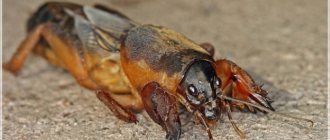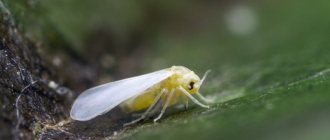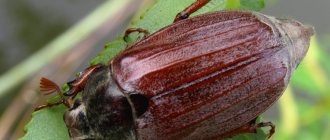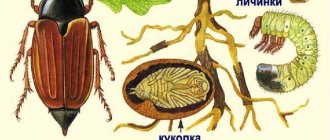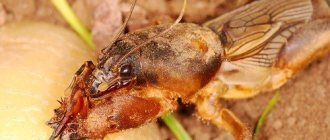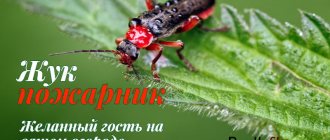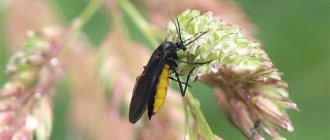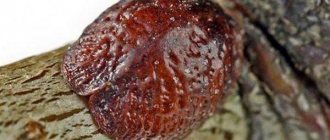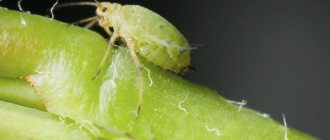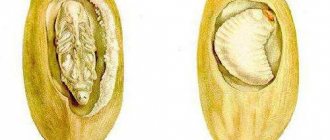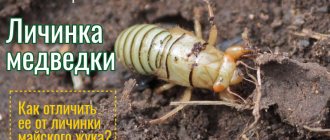Views: 1,015
There are also plenty of pests in summer cottages and garden plots. An insect like the mole cricket is one of them. Sometimes, multiplying in large numbers, this arthropod causes a lot of trouble for farmers. In this article we will look at the damage it causes and how to get rid of mole crickets in the garden. But first, let’s get to know this pest better: how it lives, what it eats, how it reproduces, where it settles, and so on. We attach a photo of the bear and a description. You need to know the enemy by sight)
Description of the insect
The shell and head of a mole cricket
Mole cricket is a major soil pest . These insects appeared on Earth before humans. This is confirmed by the found remains of the Cretaceous period.
The insect is popularly called earthen crayfish because of its appearance. On average, the length of an adult is 5–8 cm, but there are giants up to 10–15 cm in size. The mole cricket’s abdomen is soft, long, spindle-shaped with a diameter of up to 1 cm. It is colored light brown or olive. The chest is protected by a powerful shiny carapace of dark brown or brown color. In case of danger, the insect's head can partially hide under the hard chest shell.
The pest has 2 large compound eyes, long mustaches and strong jaws for gnawing stems, roots, destroying tubers, bulbs and root crops. With its front flat and jagged limbs, resembling claws, the mole cricket digs passages and holes in the soil.
The pest is shy, rarely comes to the surface, mainly at night, and during the day prefers an underground lifestyle . The mole cricket can swim and fly. The insect can rise to a height of 0.5–5 m, some species cover greater distances - up to 8 km. To do this, the adult mole cricket has shortened elytra, under which are the hind wings, folded into flagella. Moves in the dark, only at high air temperatures. When it is cold, the insect's muscles do not warm up to the required temperature.
There are 3 types of pests common in our country. The common mole cricket is found everywhere in the European part of the country; the single-spined species lives in the Volga region, and the eastern species lives in the Far East.
conclusions
In conclusion, several conclusions can be drawn:
- Mole crickets love manure, so fertilizing plants with this nitrogenous fertilizer should be avoided.
- Noise, vibration, and ultrasonic repellers are not effective, since in the ground these vibrations spread over a very limited distance.
- With proper prevention, loosening and weeding, mole crickets will be vulnerable and will not be able to harm all plantings.
What means do you use to fight mole crickets?
FolkChemical
Any available means should be used according to the recommendations. The same applies to insecticides. When open passages are identified, drugs are poured directly into this hole. Remember that mole crickets reproduce very quickly and “doing nothing” in relation to these pests equals a lack of harvest and a waste of time and effort.
Mole cricket larvae and eggs
An adult pest lives for 2 years. For the winter it remains in the soil, burrowing to a depth of 50–80 cm, or hiding in manure and humus. With the arrival of spring, when the top layer of soil warms up to 10–15°C, the mole cricket begins an active life. The pest comes to the surface of the earth in search of food and for mating.
Females make nests in advance in the ground at a depth of 10–15 cm. In them they lay from 100 to 400 oval yellow eggs . After 10–18 days, white larvae appear, looking like small spiders 15 mm long. They are inactive and initially blind, living off the yolk in the crop.
Gradually, over 2–3 weeks, the larvae grow and become similar to adults, but without wings and smaller in size. They are sometimes confused with cockchafer larvae .
After molting, they crawl out of the nest, dig tunnels and spread throughout the entire area . At first, the larvae feed on small roots, then move on to the roots of vegetables and shrubs. The larvae grow to adulthood within 12–14 months in the southern regions, and within 2 years in the northern regions. During this time, the insect molts 8–9 times, and the pest produces 1–2 generations per year.
Five rules of wrestling
To prevent insect pests from bothering you and preventing your plantings from producing abundant harvests, it is important to follow 5 rules:
- Mandatory prevention - even in the absence of obvious passages and damage to plants, prevention must be carried out at least 2 times a year by any available means.
- Chemistry is needed - in case of severe mole cricket infestations, it is important to combine available control methods with insecticides, which together will give the best result.
- Manure heaps away from the garden - if possible, it is better to move them outside the planting area. If not, remove it to the most remote areas.
- Plant marigolds, calendula, wormwood, tansy, and geranium in your area, the smell of which repels pests.
- Remove weeds and loosen the soil as much as possible, which will create unfavorable living conditions for the mole cricket.
Don't overuse chemicals. Even the safest drugs in high concentrations can be hazardous to health, accumulate in the soil and penetrate into fruits.
Signs of a mole cricket on the site
The first signs of a pest are drooping or limp plants that are easily pulled out of the ground . Upon examination, it is noticeable that someone has gnawed the stem near the root collar, and the roots are damaged. The tubers also have signs of gnawing in the form of cracks.
On the soil near the plants, holes 1–2 cm in diameter are visible, going deep into wide horizontal passages, as well as loosened ridges of earth that quickly dry out after rain. This means that there is a pest nest next to the dead plants, and the plants were destroyed so that the nest would warm up better.
If you cut off horizontal layers of soil with a shovel or a sharp knife, then after 5–15 cm the passage will come up against a dense lump. Having opened it, you will find an oval cavity-nest of the pest with many eggs or their shell, if the larvae have already appeared. The opened nest must be left in the hot sun, the eggs will dry out and die.
During the mating season - in May-June, the mole cricket sings at night . Males make specific sounds with their wings, reminiscent of the chirping and chirping of a grasshopper. This is how they attract females. More females flock to the best singers.
Reasons for the appearance and reproduction of the pest
The insect lives on fertile, manured and humus-rich soils, both in garden beds and in greenhouses. Therefore, along with manure or fertile soil brought to the site , summer residents are always in for an unpleasant surprise. Mole crickets are rarely found on dense clay soils.
In nature, the insect lives on wet lands near reservoirs and in floodplains, in abandoned areas and wastelands. It feels at ease in thickets of weeds .
Biological drugs
There are other ways to deal with mole crickets in the garden. For example, the use of biological drugs, the composition of which is safe for humans, birds and animals. These drugs include Nemabakt and Boverin.
The first contains nematodes and bacteria, which, when they enter the pest’s body, corrode its insides. The drug should be stored in the refrigerator, and transported and applied to the ground only when the air temperature exceeds 25°C. One package is required to process one hundred square meters of garden. The basis of “Boverin” is the spores of a fungus called Beauveria bassiana.
Under the influence of the drug, the mole cricket develops a disease called muskardino. Fungal spores pierce the cover of the insect, as a result of which it dies. Most often, the drug is used when growing seedlings in a greenhouse.
What crops are affected by the pest?
The pest is a polyphage - an omnivorous insect . Threatens grain, fodder, vegetable plants, berries and ornamental crops . In spring, it is dangerous for young shoots, seedlings, and seedlings of herbaceous plants. The mole cricket destroys sown grains and sprouted seeds. The roots of mature trees and shrubs are too tough for her.
Among vegetables, it often damages tomatoes, eggplants, peppers, cucumbers, carrots, beets, corn, peas, potatoes, cabbage, zucchini, onions, and lettuce . Among berry crops he loves strawberries and grapes . It can eat ripe strawberries , gnaw ripe pears, apples, and plums . The pest finds this prey by crawling out of its burrows at night. The mole cricket is not a vegetarian; it can eat earthworms, other soil inhabitants and insects, including harmful ones.
How to get rid of a mole cricket
Chemical and biological drugs
Modern chemical pest control agents can be divided into 2 groups: preparations based on imidacloprid and those based on diazinon .
Imidacloprid affects the nervous system of the pest, causing paralysis and convulsions. Diazinon blocks breathing and poisons the mole cricket. Insects die when they come to the surface of the earth.
Thunder
Bait preparation in the form of granules. The food additives included in its composition attract mole crickets more than plants. 2–3 g of the product are placed in the holes and passages of the pest to a depth of 3–5 cm with an interval between granules of 0.5–1 m. The depressions are covered with earth, compacted, and if the soil is dry, then moisten it. Use the drug 5–10 days before sowing seeds or planting seedlings. The protective effect lasts 2 weeks.
Medvetox
Available in the form of large red granules. Protects the root system of seedlings and adult plants. In the evening, the granules are laid out in holes and grooves to a depth of 3–5 cm, covered with earth and watered. To block the paths, it is recommended to distribute the drug along the perimeter of the beds. The consumption rate of the product is 30 g per 10 square meters. m.
1 granule kills 1 pest. The granules do not dissolve in the soil and protect for 3 weeks. The product is safe for earthworms. It is applied no later than 2 months before harvest.
Frontier
The drug protects for 2 weeks and does not cause addiction to the active substances. Causes the death of the pest within 3 hours after eating. The consumption rate of the product is 30 g per 10 square meters. m. Apply several days in advance or on the day of planting. Planting depth is 3–5 cm; if necessary, moisten the soil.
Phenaxin plus
Bait in the form of granules. It has a pleasant taste and smell for mole crickets. The granules are laid out both in the places where plants are placed (10 days before planting) and near manure and compost heaps.
Make furrows 2–3 cm deep in the soil, place 3–5 granules, sprinkle with earth and spill. An interval of 0.5–1 m is maintained between placement sites. The drug protects against pests for 14–20 days.
Grizzly
Destroys adults and larvae within 48 hours after treatment. The bait is introduced into the holes to a depth of 2–5 cm, 2 g per 1 square meter. m, departing from the plantings by 5–10 cm. Apply the drug in the morning or evening at an air temperature no higher than 25°C.
Boverin
A biological product based on a natural fungus isolated from soil. It is planted in the ground in wet weather, in spring or autumn. In order for the fungus to take root and begin to grow, it will need to be applied annually for 2–4 years.
The spores of the fungus, once on the pest, penetrate it and, growing inside, cause the death of the mole cricket. The dosage of the product is 400–500 ml per 10 liters of water.
Nemabact
A non-toxic biological product based on nematodes and bacteria that are dangerous to the pest. Use at air temperatures between 10–26°C and high humidity. To activate the nematodes, the drug must warm up naturally for 4–8 hours.
The product is diluted in water at a concentration of 1:100 and watered the soil. The solution should not get on the leaves; the nematode will die on them.
Traditional methods
Many summer residents “hunt” mole crickets by setting up non-chemical baits and traps .
- In autumn, the pest is caught in manure pits . They are dug to a depth of 0.5 m, filled with fresh manure and covered with earth. Pests will gather in these attractive wintering places. After the soil freezes, the manure is scattered and the mole crickets die from frost. Manure baits can be placed in May, when the pest lays eggs. After a month, the traps are checked and the adults and eggs are destroyed.
- The pest has a strong sense of smell and is caught by smell . In their habitats, mole crickets bury 0.5 liter glass jars or plastic bottles with the neck cut off, level with the soil. Porridge is made from corn, oats, peas, and wheat, aromatic vegetable oil is added and jars are filled. Additionally, karbofos and zinc phosphide are added to speed up the death of the mole cricket. Such traps should not be left unattended, as pets may be harmed.
- You can make safe baits. Insects love fermented beer and use it instead of porridge, pouring it into buried bottles and cans.
- to crushed eggshells from fresh eggs and placed in the pest’s burrows.
- The smell of kerosene repels mole crickets . Sand moistened with kerosene is scattered around the beds where the presence of mole crickets is noticed.
Chemicals
If we talk about how to deal with mole crickets, many gardeners immediately resort to chemical methods. The most popular and effective drugs are “Rubit”, “Bankol”, “Medvetox” and “Regent”. All of them are insecticides that localize the work of the central nervous system.
Under the influence of the drug, the insect first loses the ability to move, and then, within two to three days, dies. All of the above drugs have minimal toxicity and do not affect animals and birds. They become most effective after the air temperature rises to 35°C.
